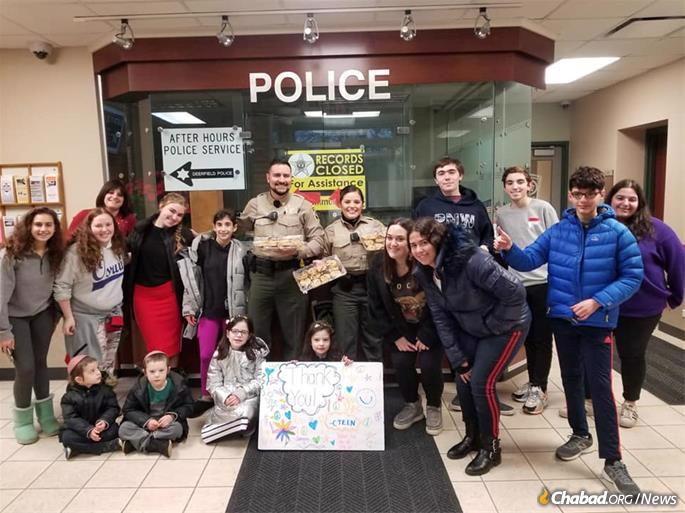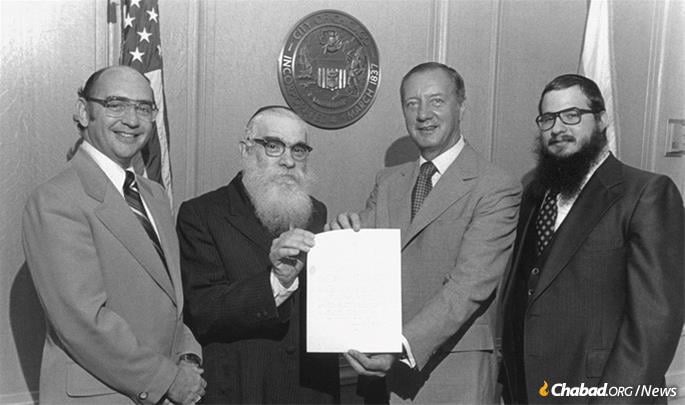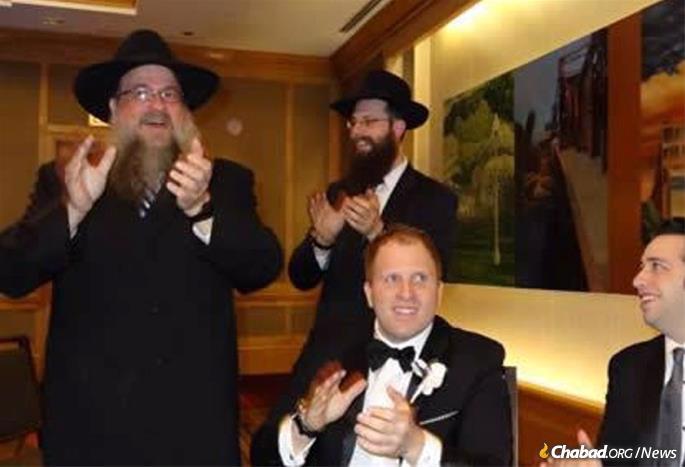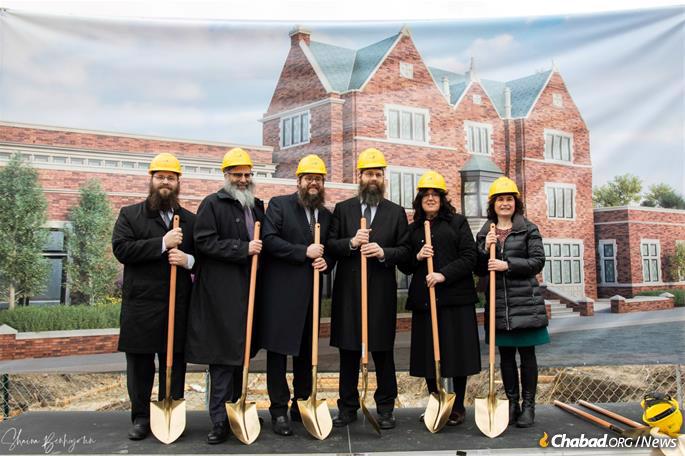
Growth of Chicago’s Jewish Communities a Study in Chabad’s Broad Impact
by Mendel Super – chabad.org
Ashley Silver, a resident of Chicago’s north shore suburb of Deerfield, Ill., first encountered Chabad in the city when she began attending Chabad at University of Illinois at Chicago, directed by Rabbi Bentzion and Chani Shemtov. “Chani really inspired me,” says Silver. “I was afraid of trying Chabad; I grew up Conservative. Maybe Chabad would be too religious? But Chani made me feel welcome.”
When she moved, Shemtov connected her with Mina Schanowitz, who directs Chabad of Deerfield, with her husband, Rabbi Chaim Schanowitz. “Mina reached out to me in our first week in Deerfield,” bringing a welcome gift to her door. Later, when Silver was in the hospital giving birth to her youngest, who was born premature, Schanowitz visited with sushi and gifts. “I realized they weren’t out there to make you something you aren’t but to connect with Jewish people and your own Judaism.”
The next suburb over from Deerfield, Highland Park, recently made headlines for all the wrong reasons: a gunman targeted a Fourth of July parade on Central Avenue—just blocks from Chabad of Highland Park, directed by Rabbi Chaim Schanowitz’s uncle and aunt, Rabbi Yosef and Michla Schanowitz—spraying the crowd and killing seven people, including members of the Jewish community.
Just days after the shooting, at Chabad of Highland Park’s Evening of Healing and Unity, Lubavitch-Chabad of Illinois’s regional director, Rabbi Meir Shimon Moscowitz, noted that the shooter was captured in nearby Lake Forest and made an announcement: “Tonight, I announce the establishment of, G‑d willing, a new Chabad center in Lake Forest; a full-time Chabad center that will join the 50 centers throughout the state and serve as a beacon of hope, of warmth and of light.”
The Jewish family experience cited by Brown—provided by emissaries like the Schanowitzes and 35 other shluchim (“emissary”) families throughout metropolitan Chicago—goes far to explain the rapid and sustained growth of Chabad in the city and the state. Statewide, over the past two decades, Lubavitch Chabad of Illinois has more than doubled its footprint, from 21 centers in 2001 to 50 in 2022—a staggering 138 percent growth.
Moreover, according to the 2020 Metropolitan Chicago Jewish Population Study, Chabad had the highest levels of engagement of any single Jewish community in Chicago with particularly high engagement in the in-person category.
“We see a shift in engagement from belonging to participating,” says Dr. Janet Krasner Aronson, principal investigator of the Chicago study and associate director of the Cohen Center at Brandeis University, which helps to explain Chabad’s expansion throughout the Chicago area and beyond. “Chabad is absolutely filling a need in the Jewish community.”
A deeper look reveals that Chabad’s growth is particularly noteworthy as it comes amid a general decline among other congregational groups, reflected in shrinking membership and synagogue closures. Data collected by urban demographers Edward Heyman and Joel Kotkin shows that during the same two decades, Illinois suffered a 35 percent decline in the number of synagogues. Excluding Chabad, between the years of 2001 and 2020, the total number of congregations dropped from 161 to 104.

A Century-and-a-Half of Storied Chabad History
This recent impact is part of a story that is almost 150 years old. Chabad-Lubavitch has been part of Chicago’s communal fabric since at least 1875, when Chassidic immigrants from Eastern Europe founded the Anshei Lubavitch congregation on the city’s West Side just four years after the Great Chicago Fire. It was followed by several other Chabad congregations, including B’nei Ruven, which eventually became the city’s largest Orthodox congregation.
By the turn of the century, Anshei Lubavitch had hired Rabbi Mordechai Zevin, a Lubavitcher rabbi from Russia, to lead the community.
Following his 1927 imprisonment by the Communist regime, theSixth Rebbe—Rabbi Yosef Yitzchak Schneersohn, of righteous memory—left the Soviet Union, settling in Riga, Latvia. Two years later, he made his first visit to the United States. A famed defender of Judaism behind the Iron Curtain, the Rebbe’s reputation was such that he was greeted by massive crowds as he traveled from city to city, bringing a message of tradition and old-world values to the new world. In February 1930, he came to Chicago, his arrival at the LaSalle Street station, the Chicago Tribune reported, “caus[ing] great excitement … as several thousand orthodox Jews fought to get a glimpse of their leader.”
The Sixth Rebbe spent two months in the Windy City, accomplishing much for the state of Torah observance. “The Rebbe expressed the hope that some day the Jewish youth of America will revolt against the prevalent condition of ignorance of things Jewish … ,” The Sentinel, Chicago’s premier Jewish newspaper,reported on May 9, 1930. “He pleaded with the Jewish leaders to devote themselves to the cause of the Jewish youth activities.”
Rabbi Yosef Yitzchak Schneersohn returned to Europe later that summer, making it back to American shores in 1940, this time as a refugee from Nazi-occupied Poland. Though by this time greatly weakened by illness and the persecution he had faced over the years at the hands of the Soviets, and thus no longer traveling, he made an exception for Chicago, visiting once again in the winter of 1942.
What was supposed to be a longer visit was cut short to just one week, due to the passing of the Sixth Rebbe’s mother—Rebbetzin Shterna Sarah Schneersohn in New York—but he still left an indelible impression on Chicago Jewry. His addresses and the circumstances of this visit would be recounted in a booklet printed shortly thereafter titled Bikur Chicago (published in English in 2019 as Touching a City’s Soulby Sichos in English with Kehot Publication Society).
By the time of the second visit, Anshei Lubavitch was without a rabbi. Recognizing that Chicago needed a young, American-born, English-speaking spiritual leader who could attract the younger generation but was also steeped in the Chassidic tradition and outlook on life, a few months later the Sixth Rebbe dispatched Rabbi Shlomo Zalman (Solomon S.) and Chaya Sora Hecht to the city. The Hechts brought a young Chassidic spirit to the city, and over the years attracted many students and admirers.
In 1947, the Hechts were joined by another Lubavitch rabbinic couple, Rabbi Hershel (Harold) and Chava Devorah (Evelyn) Shusterman, who served first in one synagogue in an older part of town before taking the helm of B’nei Ruven. Rabbi Shusterman, who was joined at B’nei Ruven by Rabbi Baruch and Chanie Hertz in 1990, led B’nei Ruven as senior rabbi until his passing in 2001.

A New Era for the Jewish Community
In 1975, as Chabad’s worldwide Jewish engagement efforts broadened, the Sixth Rebbe’s successor, the Rebbe—Rabbi Menachem M. Schneerson, of righteous memory—sent Rabbi Daniel and Esther Rochel Moscowitz to Chicago to increase Chabad activities in the city. At the time of Rabbi Moscowitz’s untimely passing in 2014 at the age of 59, their efforts had helped transform the handful of established Lubavitch congregations into a network of nearly 40 communities across Illinois.
“My husband was born in Chicago and was a product of the Hechts,” explains Esther Rochel Moscowitz. Her father-in-law, Ephraim (Frank) Moscowitz, 92, grew up at Anshei Lubavitch before the war.
“Rabbi Hecht was extremely striking,” recalled the elder Moscowitz in a 2019 conversation with Chabad.org. “He had a full beard—something we only saw on elderly visiting rabbis from Europe—wore a long frock and exuded a feeling of authority.” Rabbi Moscowitz’s parents—his mother, Tzivia (Cynthia), passed away in October at age 92—were both public school teachers who served as influential lay leaders in the community. Cynthia was an active leader in Nshei Chabad, the Jewish women’s group founded by Chava Devorah Shusterman.

Esther Rochel Moscowitz says that when she and her husband arrived, there was a foundation laid by those who had come before them that they could build on. In addition to the Hechts and Shustermans, there were the Goodmans, Kosofskys and the Silbers. The older generation did not ease up with the arrival of the Moscowitzes, either. In the early 1970s, as Jews began streaming out of the Soviet Union, Reitza Kosofsky began organizing social, religious and humanitarian programming for them. Her ad hoc efforts blossomed into a school for immigrant children and would eventually spawn several Chabad congregations in Chicago and the northern suburbs serving Jews from the Soviet Union and their children.
One of the Moscowitzes’ earliest large projects was founding a Chicago branch of Camp Gan Israel. On a more regular basis they were busy koshering homes, distributing mezuzahs, and starting Torah classes and holiday programming.
Then, in 1979, five families with young girls pioneered the first class of Cheder Lubavitch Hebrew Day School.
In the late 1970s and early ’80s, under the guidance of Rabbi Moscowitz, the first Chabad centers began to spring up. Evanston, Highland Park, Niles … year by year, more and more centers joined the ranks.
Today, Lubavitch-Chabad of Illinois is led by Moscowitz’s sons, regional director Rabbi Meir Shimon Moscowitz and executive director Rabbi Yosef Moscowitz. They’ve driven the expansion of Chabad-Lubavitch activities in the state since their father’s passing in 2014. “We are proud to carry on the mission the Rebbe sent my father on,” says Rabbi Meir Shimon Moscowitz. “Chabad has a rich history in Illinois and is deeply woven into the community fabric.”

In April, Lubavitch-Chabad of Illinois broke ground on a three-story, 18,000 square-foot campus that will serve as Chabad’s regional headquarters. The Michael S. Maling Chabad of Illinois Headquarters is designed to replicate the facade of the iconic “Seven-Seventy”—Chabad’s headquarters at 770 Eastern Parkway in Brooklyn, N.Y.
In 1982, Lubavitch Chabad of Skokie was established by Rabbi Yosef and Zeesy Posner. Located in an area with many congregations, Chabad took root and grew into a popular synagogue and educational center in the densely Jewish neighborhood. In 2004, the Posners were joined by their son and daughter-in-law, Rabbi Yochanan and Yona Posner, who lead community events, holiday programs, programming for children and teens, and adult education.
Tami Miller moved to Skokie in 2005 and immediately began searching for a preschool for her daughter. Researching her options, she called Zeesy Posner. “I was an annoying first-time mom,” acknowledges Miller, “and she was super-patient with me. I decided on her because of her incredible reputation and the gift she has in making each child feel that her day revolves around seeing them.”
Miller’s relationship didn’t end with preschool. She and her children are still active in Chabad, and her son, Zack, 17, is a leader of the Skokie CTeen chapter. The way Zack began participating in CTeen demonstrates the “kindness, generosity and inclusiveness” of the Posners and Chabad, explains Miller. When Zack needed to switch from a Jewish day school to public school, his mother was desperate to find him a safe Jewish social environment. Though he wasn’t old enough, Yona Posner and her husband Yochanan accepted Zack into CTeen, the Chabad teen network. “I have an overwhelming appreciation and love for them,” says Miller. “Zack would put Yochanan and Yona as his closest confidants. They were able to have the sensitivity to understand him, and he has a relationship with someone who he trusts and can turn to.”
She says that her son’s “growth in Torah and his spiritual growth” is because of what the Posners have provided him. “They’re a gift to the community.”

‘We Want to Attract Every Jew’
Miller notes that Chabad is able to attract a very diverse crowd: “It’s their inclusiveness, their personalities. They’re so committed to Yiddishkeit and making it feel real for the kids.”
“We care about the individual,” Yona Posner attests. “We don’t care about their color, shape, size, gender. We want to reach everyone.”
One way she accomplishes this is with “Jew Crew,” a Jewish club her husband helped sponsor at local public high schools. Several years ago, she explains, amid rising anti-Israel sentiment in certain schools, Jewish students from these high schools approached her and her husband and asked them to begin a Jewish club. The students formed the Jewish Association of Students and worked to gain the necessary staff member’s sponsorship of the club. The club’s aim is to encourage Jewish students to explore their faith and religious observance, including the only kosher-food options on campus, and provide a safe space for discussion of Jewish ideas and values. Beyond that, it serves as a resource to educate non-Jews about Judaism and foster greater understanding, with the goal of reducing antisemitism.
“We’re here for anyone looking for meaningful engagement,” says Yona Posner. “We try to reach the people who aren’t accessing that.”
To that end, they put up 25 menorahs around the city each Chanukah, adding one location every year. “Everyone knows you go to Chabad for Chanukah,” she says. “Every afternoon, we’re at an outdoor mall, giving out doughnuts and hot cocoa, and stickers reading ‘I celebrate Chanukah.’ ” As it gets dark, they light the menorah and dance with the crowds. “People feel this authentically Jewish energy.”

Drawn to Chabad’s Accepting, Proactive Approach
Throughout the Chicago region, Jewish people from the widest variety backgrounds are being drawn to Chabad. Sara Brown, for example, wasn’t looking for a synagogue or a rabbi. But then she met Chaikie Kotlarsky, and she found both.
Back in Las Vegas, where she grew up, Brown had a congregation she felt comfortable with and a rabbi she liked. When she moved to Arlington Heights, a suburb in northwestern Chicago, she was content with traveling back to Las Vegas to mark the life-cycle events, like the naming of her daughter. For Brown, that all changed when she began noticing a bearded young rabbi in her neighborhood often walking with his family. Seeing someone visibly Jewish, Brown said hello and began chatting with Chaikie, his wife.
“I would have never sought out Chabad,” Brown tells Chabad.org. “I didn’t even know what a Chabad was; I’d never heard of this concept.” Yet, she says, after she met the Kotlarskys, she was intrigued. “I wanted to know, I wanted to learn more.”
Brown soon developed a close relationship with Chaikie Kotlarsky. “We became instant besties; we connected immediately,” she recalls. “She answered all my questions. I found comfort in having someone to talk with who didn’t judge me.”
When Chaikie Kotlarsky and her husband, Rabbi Yaakov Dovid Kotlarsky, co-directors of Chabad-Lubavitch of Arlington Heights, moved to the area with their young family three years ago, there was no Jewish infrastructure to speak of. “The few Jews we knew of in the neighborhood suggested we not bother coming; they each said they were the only Jews in Arlington Heights,” says Chaikie Kotlarsky. ”Now the scene looks very different.”

Little by little, “mostly by our knocking on doors,” families began joining the fledgling community. They started with Shabbat dinners and one-on-one interactions, and today have a blossoming Hebrew school, regular Torah classes, Shabbat services and popular holiday programs. Brown, who discovered that her neighbors were much more than a rabbi, a rebbetzin anda synagogue, says she soon learned that “Chabad isn’t a temple or a congregation; it’s a family.”
It took a young enterprising couple to see the potential in the area and create a cohesive community. The familial warmth and strong sense of cohesive community that drew Brown in is echoed by the many women and men who spoke with Chabad.org for this story and for another storylast yearexploring Chabad’s resilience and growth during the pandemic.
Heyman, the demographer, identifies this proactive, pioneering attitude as the reason for the sustained expansion of Chabad. Chabad doesn’t just react to the needs of the larger, established communities, but seeks out areas with little to no Jewish infrastructure or the gaps in their coverage, reaching out to individuals overlooked and building communities from the ground up. “The Rebbe’s vision of making sure that Jews were never forgotten and never alone—anywhere in the world—and the movement to place emissaries in these environments” means Chabad will more likely than not be there when a family moves into a new town, Heyman told Chabad.org. Whether there was or wasn’t an existing Jewish infrastructure, he added, “Chabad became the point of Jewish presence.”

A Seismic Shift from Membership to Participation
Chabad, which from the beginning has had an open-door policy and thus never lived in the membership model world, has understandably grown with the wider shift of what Aronson, the principal investigator of the Chicago study, calls “belonging” to “participating.”
“With the legacy Jewish organizations, many people belong without participating,” meaning that they support, belong, or pay membership dues, but rarely attend programs, explains Aronson. She says that others are working to embrace Chabad’s model, though without the dedicated couple emissary team, it can be “challenging logistically and financially, something many communities and synagogues struggle with.”
These communal shifts mean measuring impact must change, too, she says; studying communal engagement by examining congregational membership alone is no longer sufficient. “When we would ask about synagogue membership, Chabad wasn’t captured,” she explains.
The communal need Aronson sees Chabad as filling is the “need to engage in Jewish life in a ‘no strings attached’ way. There’s no expectation to ‘join’; there’s a sense of acceptance wherever you are.”
Brown, from Arlington Heights, tried two other congregations in neighboring suburbs before settling at Chabad with her family. She says her spiritual journey since then has been an experiential one, transcending the twice-annual synagogue attendance she experienced previously. “They bring the faith back to you,” says Brown. “The rabbi came and put up mezuzahs, and I began lighting Shabbat candles. They want to know your family and bring Judaism into your home.”
Silver feels that Chabad’s success is because “it feels more like a family than a brick-and-mortar place. Other synagogues don’t offer that,” in her experience. In addition to noting the lack of sometimes expensive membership fees, Silver points to an uncomfortable reality in today’s hyper-politicized climate. She feels that the divisive politics have been seeping into what should be houses of prayer and Torah. Some synagogues, she says, have “an agenda and beliefs that you can’t necessarily fit into, while Chabad is accepting of everyone.”
A Growing Presence Downtown
While Chicago’s Jewish population is heavily concentrated in the suburbs, Chabad’s downtown presence continues to grow, today numbering seven communities. Chava Kagan, who directs Chabad of River North and Fulton Market in the heart of downtown with her husband, Rabbi Avraham Kagan, describes the local demographic as young people just starting out in life. “It’s a pivotal time in their lives when they’re figuring out who they are, getting married and having their first child,” she says, noting that once a family matures, they often end up back in the suburbs.
When Maura Nemes and her husband, Zack, moved to River North in 2013, they found Chabad newly established there. Maura Nemes describes how her husband was the more religious one, and was seeking the kind of Jewish experiences he’d had while living in New York. “He found that in the Kagans,” she says. “Before we had kids, we’d go to all the events, Shabbat services and dinners,” she says wistfully.
When their first, Harry, came along three years ago, followed by Logan last year, they discovered it was possible to engage in Judaism as a family, too. Chabad started “Baby Chino” where the moms, dads and kids all go together to schmooze, sip hot drinks and hang out together, while the little ones explore music, sensory play and art. “It’s something for all of us to do, and the kids really love it,” says Nemes.
What stands out about Chabad to her is the more casual, family-centric atmosphere. “There are other synagogues,” she says, noting that Chabad is the only option within walking distance, “it’s just that you have to belong to them. The part we love about Chabad is that it’s more intimate. I just really love Chava; she puts her heart and soul into everything. It has that personal touch. They go above and beyond, and we always have the best time.”
Nemes is excited about Chabad’s permanent location, which opened in March. “It’s been tough for them. They’ve kept growing and growing, and now they have this beautiful space around the corner.” She hopes to make the most out of the convenience before her family moves to the suburbs. And she won’t be left without Chabad there either—her friend goes to Chabad of Glencoe, established in 2019, and is eager for Nemes to join her there.

Reaching Out in a Neighborhood With No Chabad Center
Chabad’s creative and innovative spirit is the first thing that Maayan Sloan, a mother of three in Park Ridge, a northwestern suburb, noted. Park Ridge doesn’t have its own Chabad or, in fact, any Jewish communal organization. “I thought I was the only Jew in Park Ridge,” says Sloan. When she saw a post on a local Facebook group by Rivky Hershkovich of Chabad Cares, a social services organization, in next-door Des Plaines, about a Chanukah event being hosted at a Park Ridge library, she brought her kids.
“It was the greatest feeling. I couldn’t believe all these people were Jewish, and I had no idea. It was so nice to realize we weren’t alone; there were other Jews here.” That Chanukah event was the second event that Hershkovich and her husband, Rabbi Lazer Hershkovich, hosted in Park Ridge, just months before the pandemic. Throughout 2020 and afterwards, they “were so creative in finding ways to bring us together,” says Sloan.
Hershkovich and her family moved to Des Plaines, where her husband grew up, five years ago to join the team at Chabad and F.R.E.E of Niles. They focused on outreach, visiting Jews in dozens of nearby hospitals and nursing homes. As if the scope of their responsibilities wasn’t enough—they give out more than 500 holiday packages before each holiday—they began connecting with Jewish families in neighboring Park Ridge.
“Park Ridge has never had a synagogue, people thought there were no Jews here,” says Hershkovich. “We meet new people at every program we do there,” she adds, from a public menorah-lighting to children’s programs. Sloan looks forward to Chabad’s latest offering: a six-week Jewish Discovery Program, where for an hour-and-a-half children learn about Judaism through play and hands-on activities, going through the aleph bet, the prayers and other fundamentals. “What Rivky does is fascinating, the kids have the best time at every event,” Sloan enthuses.
Moving to Park Ridge, Sloan says she was worried: “I was nervous about how I’d keep my Jewish identity. I knew a lot of it would fall on me, because my husband isn’t Jewish.”
Chabad was a blessing, she continues; “it’s made Judaism a part of our lives and brought the entire Jewish community together. It’s so important knowing the kids will learn and enjoy. It’s different from going to temple and listening to a service; it’s part of the community. They make you realize you are not alone.”
Heyman, in his interview with Chabad.org last year, pointed to that welcoming spirit and authentic feel as a major driver in Chabad’s popularity. “If you’re seeking tradition, Chabad is open and welcoming. It’s the return to basics which people find resonant.”
Reaching Out to College Students
Although the 2020 Metropolitan Chicago Jewish Population Study didn’t encompass Jewish campus organizations, the influence among Jewish students in Chicago’s many colleges and universities is wide and deep. “I know this from talking to young people,” says Krasner Aronson. “Kids on college campuses can come straight to Friday-night dinner with a feeling of unconditional welcoming.”
Baila Brackman is the woman who fosters that love and care at the University of Chicago since she and her husband, Rabbi Yossi Brackman, founded the Rohr Chabad at the University of Chicago and Hyde Park in 2000.
“The community that Baila and her family provide on campus is a great space. She provides a warm and inviting environment,” says Isabel Wolfson, 22, who graduated last spring. “I didn’t grow up going to Chabad, but in my freshman year, I gravitated to Chabad. My first time was on Rosh Hashanah, then I began going all the time.”
Wolfson describes her friendship with Baila Brackman as “some of the best memories I have; just having a coffee with Baila. She had the greatest impact on me.”
“Each student changes my life,” says Brackman. “Each one makes me a better person.” Brackman, who sees herself as the “Jewish mother on campus,” says she still goes to bed thinking about “her” students each night. “I want to be sure that every student on campus has a home away from home—a place they feel comfortable to ask questions and seek answers.”

When two students recently died in tragic and horrific circumstances, Brackman was heartbroken. First, in June, Ilan Naibryf, 21, a physics major and a past Chabad student president, died in the Champlain Towers collapse in Surfside, Fla. Then, a month later, Max Lewis, 20, was killed by a stray bullet on Chicago’s South Side. Despite her own loss, Brackman supported the other students as the community grieved together.
“He was a third-year student, taking the train home. He was caught in crossfire and died,” explains Brackman, still grappling with the tragedy. “He didn’t have any prior religious background before he came to Chabad.”
It began on Simchat Torah, at Chabad’s legendary farbrengen. Another student, Dylan, was seated near the rabbi with an empty chair beside him. “You have an empty chair?” said the rabbi. “Go to the dorms and find another Jewish student to fill it.” Dylan came back with his friend, Max Lewis. “My husband put his arm around Max and talked with him until 2 a.m.,” she remembers. “He loved it so much he came back every Shabbat and then to our Sinai Scholars Jewish education classes.”
For one class, Lewis wrote a paper entirely in code. The Brackmans hired a professional to decipher it after Lewis’s death. “He wrote how he learned that all Jews are connected; just as a Magen David can’t exist without all its points, so to the Jewish people can’t exist without each and every Jew,” says Brackman. Chabad renamed their Sinai Scholars program as the Max Lewis Sinai Scholars.
This same love and care of Chabad rabbis and rebbetzins that young people feel on campus is something that Brown has experienced in Arlington Heights. Last January, Brown was diagnosed as carrying a genetic mutation that put her at high risk for cancer. She wrote about this difficult time, and the loving, communal embrace she felt as she went through it, in Chabad of Arlington Heights’ quarterly newsletter:
“Not knowing what to do or where to turn, I told Chaikie and the rabbi,” she wrote. “I put my trust in G‑d, and they were there for me every step of the way. Not only did they pray for me, they brought Shabbat dinner to my home after surgery. The rabbi came to my home, and sat with my husband and was there for him, and Chaikie checked in on me and my family daily.
“ ‘Chabad.’ It’s a word I just learned, but it means more than Judaism; it’s a family. In a time when I needed G‑d the most, a rabbi just happened to become my neighbor and his wife Chaikie a friend. Our prayers are all answered in different ways,” she concluded her piece. “Chabad was the answer to mine.”
This article has been reprinted with permission form chabad.org













